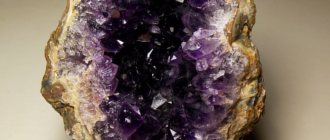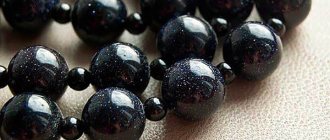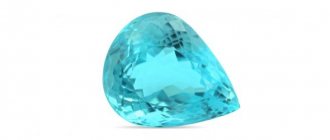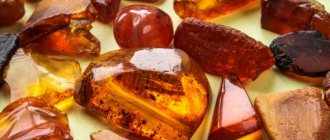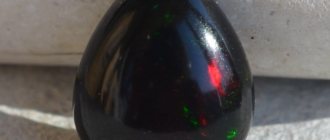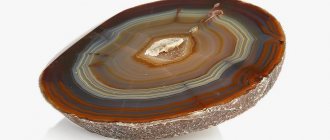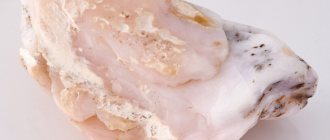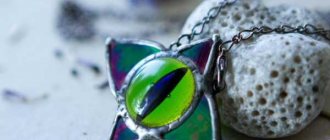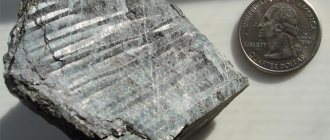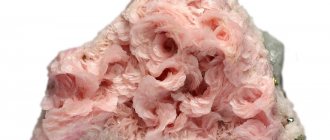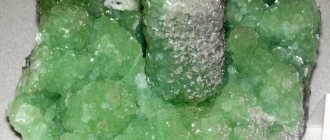Aventurine is a fine-grained variety of quartz that is most often used to make jewelry. The name translates as “accident” or “unexpected incident.” The mineral has many other names: golden sand, Colorado gold, belorechit, gold spark, spark, Indian jade.
The gem is popular not only among jewelers, but also among magic lovers - this is due to its unusual color and mystery of origin. Before purchasing aventurine, it is important to study who exactly this stone is suitable for according to their zodiac sign, and become familiar with its magical and healing properties.
History and origin
Until the 18th century, aventurine was called differently in each country. For example, the inhabitants of Ancient China called the gem “imperial stone,” and in Rus' the common name was “gold spark,” which eloquently describes the appearance of the mineral.
It received its modern name thanks to an accident when metal dust got into the hot glass blown by Venetian glassblowers, which made the banal product unique. The similarity with the popular semi-precious stone was immediately noted and the latter was given the name “aventurine” - from the Italian word “per l’avventure”, which translates as “case”.
The use of the gem in the past was not limited to jewelry. In Russia, beautiful vases, ashtrays and candlesticks were made, decorating the interior, and used for inlaying the handles of cutlery.
In China, the stone, which received the status of sacred, was used to create religious paraphernalia and decorate temples and chapels. The powers that be did not ignore the mineral either. Thus, the seal of one of the Chinese dynasties was carved from solid quartz of a rich dark green color.
Aventurine was also popular in the Victorian era. In England, it was considered good form to wear raincoats with clasps made of iridescent natural minerals and spectacular rings. It was believed that such jewelry brought good luck in love, got rid of rivals and strengthened relationships with lovers.
Aventurine fully justified its name, becoming a favorite of adventurers, gamblers and scammers. If some people wore an image of a loved one behind a hinged stone decorating a pendant or ring, others hid a bit of poison that they could use when meeting an enemy.
Place of extraction
Aventurine is a rock belonging to the quartz group. Its composition is a mixture of quartzite and mica, which is why the “star” glow appears.
Be sure to check out: What blue gemstones are called and look like
The blue variety of the stone is rare. It is mined in Jaipur (India) and in Austria (Salzburg Federal State). No deposits of the blue mineral have been discovered in Russia, but another rare species is being mined - golden brown. This gem was well known to the Slavs and was called “gold spark” among them.
The natural blue stone aventurine is often counterfeited. Even the ancient age of the jewelry and an expensive gold frame do not guarantee the presence of natural stone in it, since fakes of “Cairo Nights” have been produced since the 18th century.
Interesting! Aventurine is quite fragile, it is no stronger than ordinary ceramic tiles.
Place of Birth
There are not many places on Earth where the fine-grained variety of quartz is mined. Known deposits are located in India, China, Russia, Brazil, USA, Spain, Australia, Austria and Madagascar.
Its color depends on where the stone is mined. For example, red-brown specimens (taganaite) are mined in the Urals, and green minerals (Indian jade) are mined in India. Stones mined in America are called “Colorado gold stone” for their characteristic shine and honey hue.
Nemongo about Aventurine
Natural blue aventurine is very rare today. More common colors are dark green and dark brown. The only deposit of the stone is in India, near Jampur. The color palette is determined by the percentage of inclusions. Stone composition:
- mica;
- hematite;
- rutile and others.
The higher the percentage of hematite, the less the flickering effect will be. Due to the fact that the natural mineral can be found very rarely, its price will be quite high. Blue aventurine can easily scratch glass and other loose minerals. Only diamonds and sapphires surpass it in this.
Like any gem, blue aventurine needs careful care and storage conditions. Rings, bracelets, earrings and other jewelry should be placed in separate boxes with a soft inner surface. If the products have lost their shine and become dull, they can be washed with soapy water and then polished with a soft cloth.
Physical properties
Aventurine is a complex rock that includes not only quartz, but also mica plates: Goethite, Hematite, Magnetite and Ilmenite. An ornamental stone that has authority in the jewelry market is diverse and effective, which is due to its composition and other physical properties.
| Property | Description |
| Formula | SiO2 |
| Hardness | 7 |
| Density | 2.6 g/cm³ |
| Shine | Fatty. |
| Transparency | Opaque. |
| Color | White, pink, yellow, red, brown, green, blue. |
What does aventurine stone look like?
The honey-yellow mineral, which is mined in our country at the Taganay deposit, is rightfully considered the most beautiful. True, such a stone is very often porous, which somewhat reduces its jewelry value, but if you come across a specimen without a flaw, there will be something to admire. Don't believe me? Look at the photo:
Also rare and revered among jewelers is green aventurine mined in the area of the city of Ballari, which is located in the southern part of India. Similar stones can be found in China and the USA.
Their value will directly depend on the percentage of chromium, which, in fact, gives the mineral such an original color.
But in distant Australia, no less mysterious than aventurine itself, blue gems are mined. Due to their resemblance to the enchanting starry sky, they are also called the Night of Cairo, although there has never been a purple stone near this city.
If you want to choose the brightest variety of quartz so that it has the strongest shimmer, you should look for cherry aventurine in jewelry stores.
Despite the fact that such a stone cannot be called rare, its beauty does not detract at all from this fact. To an amateur who is inexperienced in stone matters, it may even seem that the red pellet is filled to the top with golden sand.
In addition, there is black, brown, brown, pink and even white aventurine. If you need a specific color for your talisman, you can always find it. The only question is the price.
Medicinal properties
Each natural mineral has a number of abilities that can help in the treatment of certain diseases. For example, jewelry with gems effectively treat skin diseases (rashes, eczema, warts), stop hair loss, and calm the nervous system.
The stone perfectly normalizes blood pressure, prevents the formation of blood clots, improves the functioning of the circulatory system, accelerates recovery from colds or bronchitis, and has a beneficial effect on the digestive tract. Aventurine stabilizes metabolism, cleanses the body of toxins and waste.
Also read: Danburite – decoration of mineralogical collections
However, you should wear the mineral for medicinal purposes with caution. This is due to the fact that the gem over a month of continuous use accelerates all processes occurring in the body, which can lead to imbalance and deterioration of well-being.
The best schedule for lithotherapy with a gemstone is a week of use and 2 days of rest, during which the mineral will have time to fully cleanse itself and the body will rest. The second option is to wear the stone three times a week, rinsing it under running water after each use.
The healing stone has the most favorable effect on the body during the waning moon. During growth, the influence of the mineral weakens and does not have such a clear therapeutic effect.
If you have problems with the cardiovascular system, it is preferable to wear rings, bracelets or pendants with gems. To solve problems in the respiratory area, spectacular beads will be the optimal solution.
Earrings are effective for activating metabolism and calming nerves. For skin diseases, massage of the affected area with aventurine is indicated, or it is better to wear the stone in close proximity to the problem area.
Brief mineralogical information
Aventurine is a mineral that is silicon (IV) oxide SiO2. This is quartzite with a characteristic fine-grained structure. Various inclusions of unevenly dispersed mica make it possible to classify the gem as an unusual stone. Interestingly, the color of the mineral can vary. Numerous photos of the mineral itself and jewelry are proof of this.
What does real aventurine look like? For example, specimens from the Ural mines are reddish-brown due to inclusions in the form of hematite particles, while those from India and Austria are dark blue. There are known deposits in India where the green-tinged mineral is mined due to inclusions of fuchsite. There are specimens of sunny yellow color. It was yellow aventurine that received the name “golden sand”. The smallest scaly inclusions, shimmering, create the illusion of fine-grained golden sand.
Magic properties
Aventurine is a strong and mysterious gem. It was often used in the distant past and is used today for magical rituals. It is believed that the magic stone aventurine is saturated with positive energy:
- improves financial condition;
- brings good luck in love and work;
- reveals hidden abilities and talents;
- develops intuition and leadership qualities;
- favors creative people, calling on the muse and helping to overcome crises.
Aventurine as a magic stone is chosen by color:
- Green minerals are recommended for loving people who want to preserve and increase their feelings, protect them from rivals and increase passion in relationships. Aventurines are also loved by players who believe that the stone promotes luck in cards.
- Aventurines of a golden-green hue can ward off evil glances, envy and damage. This is why amulets with stones are often hung in a child’s room. They not only protect the baby from bad energy, but also prevent illness.
- Blue aventurine is a protector, indispensable on long trips and travels. It protects against problems that arise along the way, increases attentiveness and has a beneficial effect on the mental state if the astrological compatibility of the mineral with the traveler is taken into account.
Black aventurines are considered the most mysterious and beloved magicians. Gems that reveal the subconscious and establish cosmic connections are used during meditation and when searching for answers to vital questions. Talismans with a black stone are recommended for businessmen, who help increase their wealth and protect them from evil intentions on the part of others.
Aventurine is a stone that reacts sharply to the phases of the moon. Thanks to this rare quality, the mineral can be “charged” with the energy of the heavenly body, simply by leaving it overnight on the windowsill.
Summarizing information
Who is suitable for blue and natural aventurine? Natural stones have a number of useful qualities that have been used for thousands of years. The energy of the bowels of the earth can cure many ailments and influence human behavior and mood. Blue aventurine is one of the most mysterious crystals. Today, natural stone is quite difficult to find, and accordingly its price will be sky-high.
In stores, for the most part, you can find an artificial analogue of “Cairo night”. It is practically no different from natural and has almost the same properties. As you know, each zodiac sign has its own gem. Aventurine protects earth signs. Neutral towards water. Fire signs are contraindicated from wearing amulets made from this mineral. Air signs can wear it once or twice a month, when there is an urgent need to make the right decision, there may be somewhere to take a risk, but they cannot decide this on their own. Constant wearing, every day, is not recommended even for earth signs. The influence of the stone is too powerful, even on people whose biofield is particularly strong. Experienced esotericists themselves do not wear such a ring every day.
Jewelry with mineral
Jewelry with stones is presented in almost every jewelry store. The assortment of products includes feminine beads, elegant earrings, spectacular bracelets, and laconic rings. A wide range of stone shades allows you to choose the optimal solution for any color type.
Also read: Fluorite - a stone that glows in the dark and under ultraviolet light
The cost of jewelry depends on the material in which the gem is framed. For example, earrings with aventurine can be bought for 3,000 rubles, gold jewelry with the mineral will cost 23,000 rubles. The cost of beads varies from 900 to 3000 rubles, and the price of a silver ring starts from 800 rubles.
Aventurine is often combined with other stones in products. The gem harmonizes best both aesthetically and energetically with agate and amethyst, beryl and pearl, turquoise and coral, emerald and sapphire, lapis lazuli and carnelian.
Contraindications
Astrologers do not recommend buying mythical jewelry for people of the fire element. Aries, Sagittarius and Leo already have strong energy, and are also distinguished by their temper and tendency to take risks. Therefore, the stone will only strengthen and aggravate these traits, bringing conflicts and negativity into their lives.
Capricorns should also choose jewelry made from aventurine with caution, since the mineral can enhance the dominant cynicism and fatalism of this sign.
It should be noted that if the owner is frivolous and frivolous, then one should also refrain from such jewelry.
Women need to follow the recommendations for the use of amulets, since their emotional sensitivity and energy field are most pronounced.
Varieties of gems
Jewelry aventurine amazes with its color diversity. Today, shining stones are mined in golden cherry, brown, honey yellow, pink, blood red, cherry white and striped shades.
But the most famous and inexhaustibly popular among buyers are the minerals of blue, green, black, and pearlescent (metallic) colors. Each variety differs in structure, grain size, degree of density and color characteristics.
- Blue aventurine, which has a second name - “Cairo Nights”, in its external characteristics resembles a miniature Universe, dotted with myriads of stars. Sparkling sparkles give the stone exceptional brightness and unusualness, highly valued by jewelers around the world.
- Green mineral (“fuchsite”) is the most durable and evenly colored aventurine, the most common and popular of all existing ones. It contains chromium, which colors the mineral green, as well as mica, which makes the stone shine. It is distinguished by its ability to become iridescent - it changes shade depending on the lighting.
- Black aventurine attracts with its mystery and unusualness. The stone looks as impressive as possible - as if the night sky is dotted with millions of stars of different sizes. The density of the mineral is low, it can be compared with the characteristics of blue aventurine.
- Mother-of-pearl stone or “belorechit” is named after the Altai River Belaya. It has a dense, fine-grained structure that is perfectly amenable to polishing, allowing you to turn the surface of the mineral into a real mirror. The color of such a stone can be different - from almost white to cherry.
Blue stone with history
Precious and semi-precious stones served not only as decorations, but also as amulets and talismans for their owners.
Aventurine was valued in ancient Egypt and China. In particular, the seal of one of the emperors of the ruling dynasty of China was made of this stone. It emphasized the status and power of its owner.
In medieval Europe, the mineral was also held in high esteem due to its beauty, depth of shade and rarity. It was this enchanting shade of dark blue color and the peculiar internal shimmer of the stone that became the prototype of the famous Murano glass of dark blue shimmering shades. It is produced on the Italian island of Murano near Venice.
How to distinguish a fake?
Buying natural aventurine is a real gamble! Natural stone is highly valued in the jewelry market and is often counterfeited.
And if some unscrupulous sellers offer frankly low-quality goods that can be distinguished from the original with the naked eye, then others make stones that almost completely replicate the mineral, while forgetting to mark “IM” (imitation) on the tag.
You can distinguish real aventurine from a fake if you choose the mineral carefully! If you have glass in front of you, you can recognize it by a large number of pronounced inclusions. A natural mineral will not be as shiny. It is important to pay attention not only to the quantity, but also to the size and shape of the glitter. On a real mineral they will be different in size and unevenly located.
Natural gems cannot be perfect. Their color is different even in one set of jewelry. If, when choosing earrings in charming aventurine, you do not see the slightest difference in shade between them, this is a fake.
Also read: Onyx - magical and healing properties of the mineral
Aventurine in products and jewelry
The most famous product made of aventurine (light color) is a bowl located in the Hermitage Museum (St. Petersburg). The height of the product is about 150 cm, the width is about 250 cm. The bowl was made by Ekaterinburg stone-cutters in the 20s of the 19th century. Rising on a pedestal in the center of St. George's Hall, the bowl gives a special solemnity and monumentality to the room.
Processing the stone in the form of a cabochon or cutting aventurine products undoubtedly enhances the aesthetic perception of the product. Cutting the mineral into silver, cupronickel (an alloy of copper, most often with nickel) adds beauty and grace to earrings, pendants, and rings. Beads of faceted or round shape enhance the effect of richness and completeness of the product.
How to distinguish natural stone from fake?
Recently, quite a lot of crafts and jewelry have been produced, and of high quality, based on synthetic aventurine. Even in photos of products in advertising brochures and on websites, the bright and thick color, shine and shimmer catches the eye. Cabochons (smooth stones with a convex surface processed in a special way) and jewelry based on synthetic aventurine often look more impressive than natural ones, while having a relatively low cost.
There are several simple techniques and rules for distinguishing an original from a fake:
- Due to the medium hardness of aventurine, it can be cut with a diamond cutter, which will leave a line.
- Aventurine scratches glass, but fakes do not.
- Natural stone has an uneven surface, with less pronounced color and shine of inclusions. The internal shimmer of natural aventurine is also less pronounced.
- And, most importantly, the dark blue stone is a fairly rare mineral with a corresponding price. Therefore, products made from real gems cannot be cheap.
- The healing and energetic effect in the artificial gem is completely absent.
Caring for stone products
Aventurine is a rather capricious stone. You can preserve its pristine beauty, color and shine by following simple rules for storing items with gems and caring for jewelry.
- The mineral should not be exposed to sudden temperature changes, so it is better not to wear your favorite earrings before going out into severe frost.
- The appearance of the gem suffers from ultraviolet radiation, so it should be kept away from direct sunlight.
- Aventurine, due to its softness, is very easy to damage. You can minimize the risk of scratches and chips on the surface by keeping soft gem jewelry separate from other jewelry.
- Chemicals when caring for products with stone are unacceptable. The maximum you should use when cleaning aventurine is a soap solution.
- Do not forget to periodically rinse the mineral under running cold water. This will not only clean the product from dust, but will also remove the negativity accumulated during wear.
How to wear and care
It is recommended to clean aventurine from dirt using a soft cloth, first moistening it in warm water and soap. It is best to remove any remaining moisture with a dry cloth. To store the gem, it is preferable to use a leather bag or a closed box. It is advisable to store the mineral separately from other jewelry and in a cool, dark place.
The best time to wear aventurine is during the waning moon, since at this time the talisman is at its most effective.
Important! To avoid damaging aventurine, you should avoid contact with stones such as diamonds, emeralds or beryl, as well as with other hard objects. In addition, you cannot use tooth powder or concentrated cleaning compounds to remove stains from the gem.
Compatibility with names and zodiac signs
The astrological properties of quartz have always been of interest to specialists who have been studying the interaction of the energy of stones and zodiac signs since ancient times.
The date of birth of a person determines how strong the influence of the mineral will be on his life. That is why, before going to a jewelry store for an original gift, it is worth finding out who will be most suitable for aventurine.
(“++” – the stone fits perfectly, “+” – can be worn, “-” – is strictly contraindicated):
| Zodiac sign | Compatibility |
| Aries | — |
| Taurus | ++ |
| Twins | + |
| Cancer | + |
| a lion | — |
| Virgo | ++ |
| Scales | + |
| Scorpion | + |
| Sagittarius | — |
| Capricorn | + |
| Aquarius | + |
| Fish | ++ |
- Aventurine of any shade is suitable for Virgos. It makes representatives of the sign softer, develops their senses and helps them overcome difficult life situations.
- Blue aventurine is best suited for Taurus. The stone eliminates despondency and mundaneness, fills life with romance, and teaches the most reserved and down-to-earth individuals to dream.
- Aventurine gives Pisces a boost of energy, teaches them to be persistent and courageous. This zodiac sign, with the help of the mineral, shows all the best character traits.
With emotional representatives of fire signs (Sagittarius, Leo and Aries), as well as with reserved Capricorns, the aventurine has a rather complicated relationship. The gem in these cases can provoke financial difficulties, quarrelsomeness and hysteria.
When choosing an effective talisman, the name with which the energy of the mineral will harmonize is also important for a person. Aventurine is best suited for women who bear the following names: Alexandra, Larisa, Oksana, Evgenia, as well as representatives of the stronger half of humanity - Alexanders, Ruslans or Stepans.
Is this stone right for you?
Prices for blue aventurine
Natural gem has a high price. The cost also depends on what metal it is framed with:
- in gold – 100 dollars per 1 g;
- in silver – 10 dollars per 1 g.
Blue aventurine is a rare and beautiful mineral that has powerful energy. It attracts people with the same thing that attracts them to risk and adventure.
If you have bought blue aventurine or encountered its magical properties, share your impressions in the comments. We will be grateful for your repost on social media. networks.
Advice from scientists
The cosmic forces of minerals can not only help, but also hinder and ruin fate. That is why you should not only know who is suitable according to your sign, but also who is dangerous. There is a list of signs who should not purchase it. Dangerous compatibility is established for the following zodiacs:
- Aries;
- Sagittarius;
- A lion.
When close to original jewelry, fire constellations become cynical and aggressive. Facts of manifestations of fatalism and aggression have been revealed. People of these signs become hysterical, quarrelsome and difficult, almost unbearable, to communicate. Aventurine stones are not suitable for these signs if they are related to finance. The work will not work out, material difficulties and financial problems will arise.
Capricorns must exercise caution. What other zodiac sign should know about abilities:
- Pisces, Scorpios. It will help you achieve your goal and get the necessary energy potential.
- Gemini, Aquarius, Libra. Will become a talisman of good luck and success in love.
Constantly wearing a gem will lead to carelessness and gullibility, then true feelings may pass by. Here you should know that all signs must have a sense of proportion and observe the caution recommended by astrologers.
The original or a fake
You need to understand that currently most jewelry and crafts are made of glass with a characteristic aventurine shine. It is no less beautiful than natural samples, but, unfortunately, does not carry with it the properties of a natural mineral. Are there simple visible differences? Of course have.
- Artificial aventurine is brighter, with a more saturated color.
- Its inclusions in the form of sparkles are distributed evenly and in greater quantities.
- The sparkles themselves are large in size compared to the original.
To be fair, it should be noted that there are also fairly high-quality fakes. In this case, only analysis in a physical and chemical laboratory will help.
As for the general characteristics of this mineral:
- Hardness on the Mohs scale is around 6.5 out of 10, density is 2-2.5 g/cm³. In terms of hardness, aventurine resembles glass or floor tiles. It can be scratched with a file and processed with diamond.
- The amount of chromophores (inclusions that give color and characteristic shine to the mineral) is from 5 to 15%.
Interestingly, the shimmering effect is completely absent in aventurine with hematite.
Types and colors
Due to various inclusions and impurities, aventurine has a large number of color variations. The varieties differ not only in color, but also in uniformity and the number of inclusions.
So, the types and colors of aventurine:
- Green aventurine is uniformly colored, and its color varies from light green to green. This type is sometimes confused with jade or jadeite, but unlike them, aventurine always contains shiny inclusions that can be seen in the sun. It is the most durable type.
- The pink appearance is homogeneous, consists of small particles, and the sparkle is weakly expressed.
- Honey yellow shines very brightly, with a pearlescent sheen. It is homogeneous, however, often with a defect in the form of porosity.
- The golden-cherry homogeneous variety has the brightest color and noticeable sparkle; it can shine through in a layer of less than 5 mm.
- Brown aventurine has a high density, uniform, uneven color.
- The cherry white appearance has stripes and spots distributed in white or rose quartz, one of the most variable colors.
- The vaguely banded white stone is one of the least sparkling, but has an interesting pattern of interrupted stripes.
- The blue and black varieties are the rarest, and often become victims of numerous counterfeits. The brightest shiny inclusions that stand out against a dark background are most noticeable in them.
